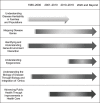The Evolving Field of Genetic Epidemiology: From Familial Aggregation to Genomic Sequencing
- PMID: 31509181
- PMCID: PMC7036654
- DOI: 10.1093/aje/kwz193
The Evolving Field of Genetic Epidemiology: From Familial Aggregation to Genomic Sequencing
Abstract
The field of genetic epidemiology is relatively young and brings together genetics, epidemiology, and biostatistics to identify and implement the best study designs and statistical analyses for identifying genes controlling risk for complex and heterogeneous diseases (i.e., those where genes and environmental risk factors both contribute to etiology). The field has moved quickly over the past 40 years partly because the technology of genotyping and sequencing has forced it to adapt while adhering to the fundamental principles of genetics. In the last two decades, the available tools for genetic epidemiology have expanded from a genetic focus (considering 1 gene at a time) to a genomic focus (considering the entire genome), and now they must further expand to integrate information from other "-omics" (e.g., epigenomics, transcriptomics as measured by RNA expression) at both the individual and the population levels. Additionally, we can now also evaluate gene and environment interactions across populations to better understand exposure and the heterogeneity in disease risk. The future challenges facing genetic epidemiology are considerable both in scale and techniques, but the importance of the field will not diminish because by design it ties scientific goals with public health applications.
Keywords: -omics; genetic epidemiology; genome-wide study designs; genomics; public health genetics.
© The Author(s) 2019. Published by Oxford University Press on behalf of the Johns Hopkins Bloomberg School of Public Health.
Figures


Similar articles
-
[Future prospects of molecular epidemiology in tuberculosis].Kekkaku. 2009 Dec;84(12):783-4. Kekkaku. 2009. PMID: 20077862 Japanese.
-
Genetic epidemiology with a capital E, ten years after.Genet Epidemiol. 2011 Dec;35(8):845-52. doi: 10.1002/gepi.20634. Genet Epidemiol. 2011. PMID: 22125223 Review.
-
Prospects of genetic epidemiology in the 21st century.Eur J Epidemiol. 2003;18(7):607-16. doi: 10.1023/a:1024933620315. Eur J Epidemiol. 2003. PMID: 12952133 Review.
-
The era of genomic epidemiology.Neuroepidemiology. 2009;33(3):276-9. doi: 10.1159/000235639. Epub 2009 Aug 20. Neuroepidemiology. 2009. PMID: 19696518 Free PMC article. Review.
-
Integrative Analysis of Multi-omics Data for Discovery and Functional Studies of Complex Human Diseases.Adv Genet. 2016;93:147-90. doi: 10.1016/bs.adgen.2015.11.004. Epub 2016 Jan 25. Adv Genet. 2016. PMID: 26915271 Free PMC article. Review.
Cited by
-
Ethical considerations for genetic research in low-income countries: perceptions of informed consent, data sharing, and expectations in Nicaragua.Eur J Hum Genet. 2024 Oct;32(10):1278-1284. doi: 10.1038/s41431-023-01505-7. Epub 2023 Dec 5. Eur J Hum Genet. 2024. PMID: 38052907 Free PMC article.
-
Genetics in bicuspid aortic valve disease: Where are we?Prog Cardiovasc Dis. 2020 Jul-Aug;63(4):398-406. doi: 10.1016/j.pcad.2020.06.005. Epub 2020 Jun 27. Prog Cardiovasc Dis. 2020. PMID: 32599026 Free PMC article. Review.
-
Associations between indicators of socioeconomic position and DNA methylation: a scoping review.Clin Epigenetics. 2021 Dec 14;13(1):221. doi: 10.1186/s13148-021-01189-0. Clin Epigenetics. 2021. PMID: 34906220 Free PMC article.
-
Genetic Epidemiological Analysis of the Keratoconus Genetic Model in the Chinese Keratoconus Cohort Study.Invest Ophthalmol Vis Sci. 2025 Aug 1;66(11):30. doi: 10.1167/iovs.66.11.30. Invest Ophthalmol Vis Sci. 2025. PMID: 40793856 Free PMC article.
-
ERS International Congress 2020: highlights from the Epidemiology and Environment Assembly.ERJ Open Res. 2021 Mar 15;7(1):00849-2020. doi: 10.1183/23120541.00849-2020. eCollection 2021 Jan. ERJ Open Res. 2021. PMID: 33748260 Free PMC article.
References
-
- Mendel G. Experiments Concerning Plant Hybrids [in German]. Proceedings of the Natural History Society of Brünn (IV). 1865.
-
- Neel J, Schull W. Human Heredity. Chicago, IL: University of Chicago Press; 1954.
-
- Morton N. Outline of Genetic Epidemiology. Basel, Switzerland: Karger; 1982.
-
- Huang PC, Cohen BH, Lilienfeld AM, eds. Genetic Issues in Public Health and Medicine. Springfield, IL: Charles C. Thomas; 1978.
-
- Khoury MJ, Beaty TH, Cohen BH. Fundamentals of Genetic Epidemiology. New ed. Oxford, United Kingdom: Oxford University Press; 1993.
Publication types
MeSH terms
LinkOut - more resources
Full Text Sources
Miscellaneous

